Thomas and his wife Sarah had eight
sons and a daughter who were all involved with
canals:
| George |
born 9th August, 1788 |
Had boatyards at Wolverhampton and Netherton |
| Thomas |
born 27th February, 1790 |
Had a boatyard at Caponfield and
worked at the Tipton boatyard |
| William |
born 22nd July, 1792 |
Had boatyards at Selly Oak and Tardebigge near Bromsgrove |
| Edward |
born 21st February, 1794 |
Had a boatyard at Smethwick |
| Elizabeth |
born 30th September,
1798 |
Married a boat builder at Berkhampstead on the Grand Junction
Canal |
| Joseph |
born 26th December, 1800 |
Had boatyards at Warwick and
Stratford |
| John |
born 22nd May, 1803 |
Worked at Tipton boatyard, died
young |
| Samuel |
born 3rd June, 1804 |
Had a boatyard at Bordesley |
| James |
born 14th April, 1806 |
Worked at Tipton boatyard, died
young |
The Tipton boatyard flourished.
There were soon around 130 boats carrying all
kinds of goods between the Midlands, North
Staffordshire and London. Thomas was credited
with the introduction of cabins on canal coats.
The boats became known as 'Monkey Boats', a name
that was eventually applied to all boats on the canal
that carried a cargo.
Around 1820 Thomas introduced a
passenger service between Factory Bridge at
Tipton and The Wagon and Horses at Birmingham.
He built a specially designed boat called
'Euphrates', a fly boat with rounded sides and a
keel so that it could travel quickly through the
water. It was of lightweight construction with a
wedge shaped front. The horses travelled at an
unbroken trot and were changed every few miles.
'Euphrates' became known as the 'Monkey Fly
Boat' and was captained by a local man, John
Jevan. It operated a two-hour passenger service
to Birmingham on Mondays, Thursdays, and
Saturdays, leaving Tipton at a quarter past
eight in the morning, and returning from
Birmingham at 5 o'clock on the same day. It
called at Dudley Port, Oldbury, Spon Lane, and
Smethwick. On Tuesdays, Wednesdays, and Fridays
it was available for private hire, and
excursions.
In 1830 the service was extended
to Wolverhampton, running daily along the old
main line. After the building of the new main
line, 'Euphrates' also ran from the Packet Inn at Wallbrook to Birmingham through the newly built
Coseley Tunnel. The boat continued to carry
passengers until the Stour Valley Railway opened
in 1852. It was then stored at William Monk's
yard at Selly Oak.
Thomas Monk senior died at
Tipton on 3rd August, 1849 and is buried in St.
Thomas's Churchyard, Dudley. The business
survived until the 1930s. The last family member
to run the business was Thomas's great, great
grandson also called Thomas. At that time the
business had a boatyard at Monk's Wharf near
Selly Oak Junction on the Worcester and
Birmingham Canal, and mainly carried coal, and
furnace slag for road making.

A boating family sitting on the wall
by The Fountain Inn, overlooking the
old main line. From an old postcard.
The
local canals were extremely busy. There were a
number of other carrying companies based on
various wharves in the Tipton area. Some, like
Thomas Monk had fly boats carrying all kinds of
goods over the canal network. Some of the
carriers had conventional slow canal boats
hauled by a single horse, often concentrating on
a single type of cargo such as coal, limestone,
iron, hay, flour, or barrels of beer. A flour
warehouse stood beside the old main line at
Tipton Green until the 1940s. Townshead's
Warehouse stored sacks of flower that had been
milled at the company's flour mill in Worcester.
One of the better known companies was Fellows
Morton & Company which later became Fellows
Morton & Clayton. James Fellows had a canal
carrying company in West Bromwich before moving
to Toll End in 1841. After his death in 1854 his
widow Eliza ran the business until their son
Joshua was old enough to take over. The business
grew to such an extent that in the 1850s he was
transporting 13,000 tons of iron annually
between Birmingham and London. A new boat
building yard was built at Tipton, and by the
early 1860s the firm's fleet had grown to over
fifty boats.
In 1876 the firm
became Fellows Morton & Company when Frederick
Morton joined the business, which continued to
expand. The final partner, Thomas Clayton, joined
the business in 1889 and the company became
Fellows Morton & Clayton Limited. Thomas had
taken over from his father William Clayton who
died just before the formation of the new
company. William had a large yard and wharf at Oldbury and specialised in transporting liquid
waste from gas works and carrying it to various
chemical works. He carried large amounts of
ammonia rich gas water used to produce
fertiliser, and tar in his tar boats to tar
distilling companies.
At the time
of the formation of Fellows Morton & Clayton
Limited, on 3rd July, 1889 the firm had around
eleven steam boats and 112 butty boats.
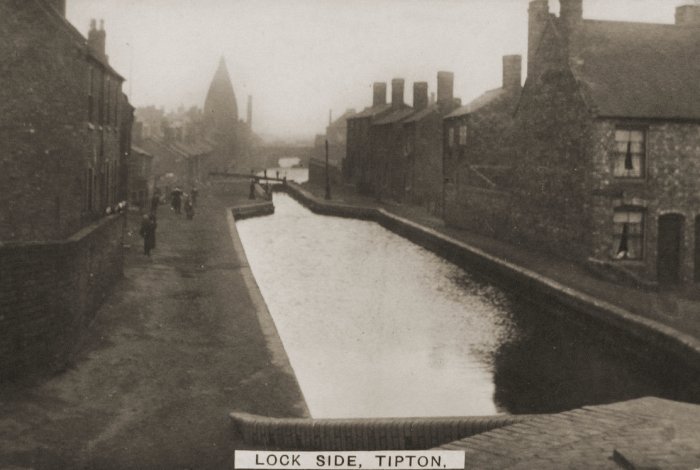
The Tipton Green Branch. The area where the houses stand was
called 'Lock Side'. The bridge in the distance carries Elliott's
Road and was next to one of the tollhouses. From an old
postcard. |
|
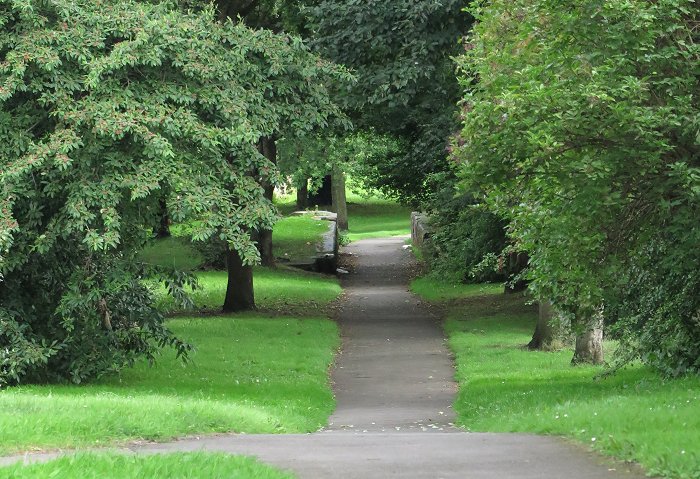
The Tipton Green Branch today. |
Other local carriers included Pickford &
Company, Crowley & Company, Bissell, and
Whitehouse. Crowley & Company had a yard at
Tipton Green from where their fly boats
travelled daily to London, Liverpool, Manchester
etc. The yard was also used by Pickford &
Company.
John Whitehouse & Sons
also had a yard at Tipton Green from where fly
boats travelled daily to London, Liverpool,
Manchester, Bristol, Worcester, Birmingham, and
Shrewsbury.
Three times a week
fly boats travelled from John Bissell's Wharf at
Tipton Green to London, Liverpool, Manchester,
Shardlow, Hull, and Gainsborough.
Tildasley and Sturland also had a wharf at
Tipton Green from where fly boats travelled
three times a week to London, Liverpool,
Manchester, and Worcester etc.
In
1784 the Birmingham Canal Navigations Company
built a huge pumping station at Ocker Hill to
pump water from the Walsall Canal via a tunnel,
to the higher Ocker Hill Branch to keep it
topped-up. The resident engineer was Timothy
Hackworth. It continued in use until 1948, and
was demolished in 1960.
The
spiritual needs of the boating families were not
forgotten. In 1892 The Boatmen's Mission was
built by the Incorporated Seamen and Boatmen's
Friendly Society thanks to financial assistance
from the Earl of Dudley. The foundation stone
was laid on 26th November, 1892. The building,
on the old main line, near to Factory Bridge
still survives today, but has a different use.
On the opposite side of the old main line is one
of the last surviving stables, Malthouse Stables
built in 1845. The building originally had
fourteen cobbled stalls for horses on the ground
floor. The rooms upstairs were used for storage.
It continued in use until the 1920s and lay
derelict until restoration in 1982 when it
became a water activity centre.
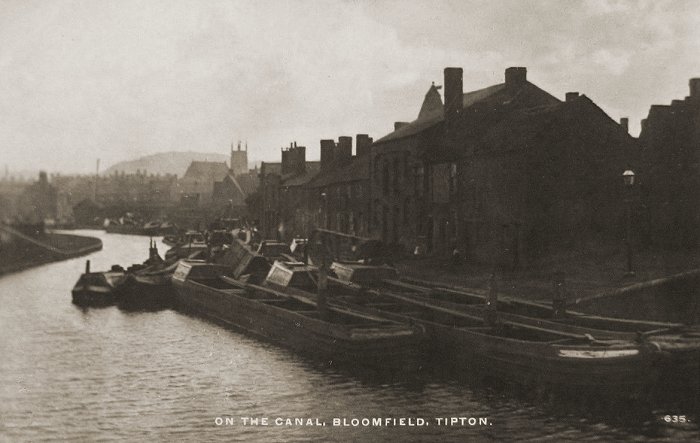
Looking along the old main line towards St. Matthew's Church. On
the right is the Malthouse Stables building. From an old postcard. |
|
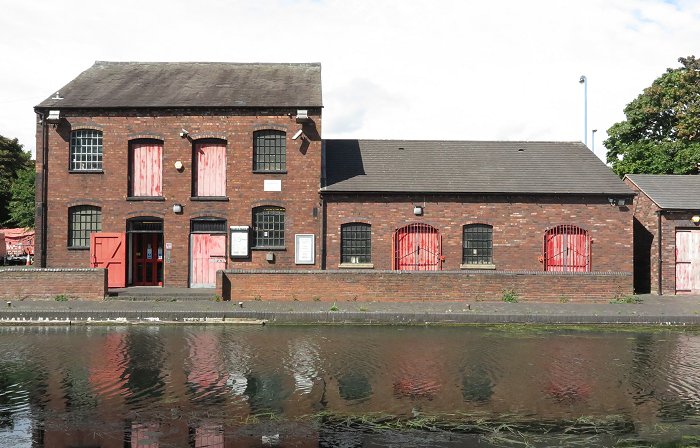
Malthouse Stables today. |
Another interesting structure on the canal is
the old lifting bridge that was built in Factory
Basin Goods Yard in 1922. When the yard closed
in 1968 it was taken to the Staffordshire County
Museum at Shugborough, before being acquired by
the Black Country Living Museum in 1977, where
it can be seen today.
|
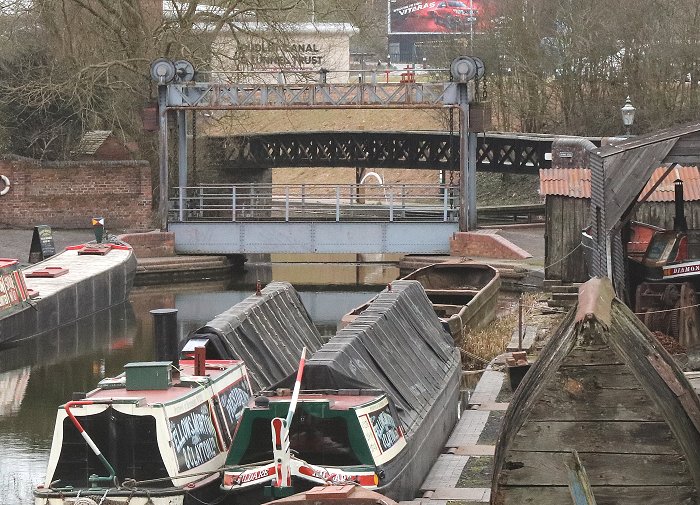
The lifting bridge, as it is today at the Black Country Living
Museum. |
One of the surviving canal buildings near to
Factory Bridge is the boat gauging house that
was built in 1873. The BCN Company, like the
other canal companies made a significant part of
its income from the charges that were levied on
carrying boats. The use of gauging was allowed
under the terms of the 1811 Birmingham Canal
Act. The charge depended upon the weight of the
cargo, and so some method was needed to quickly
assess this at the toll houses where the charges
were paid. The BCN used the dry system in which
an empty boat was placed in a gauging dock, and
one ton weights were placed in the boat. As
weights were added, the boat would lie lower in
the water, and the water levels were marked on
the side, so that they could be quickly read-off
when the boat was loaded with its cargo. New
boats and boats that had gone for a refit were
marked in this way. Each boat with a wooden hull
had to be re-gauged every few years because it
would gradually sit lower in the canal, as its
hull became saturated with water.
The gauging house originally held two gauging
docks and could handle any size of boat that
operated on the canal, including the so called 'Amptons'
that were wider and longer than other boats.
There were also cranes to load and unload the
weights. The building is now Grade II Listed.